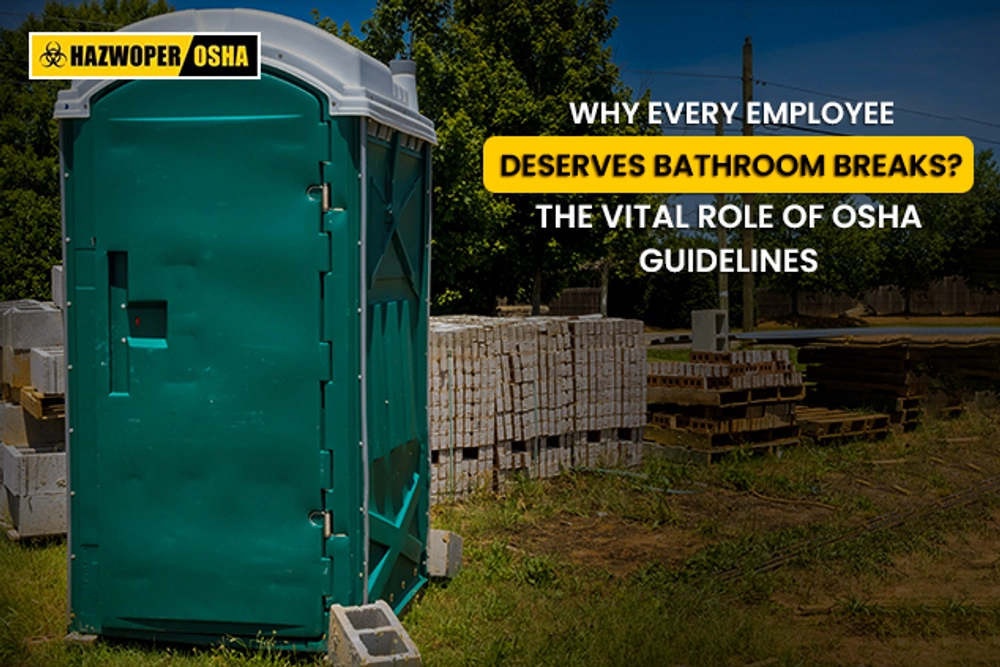Why Every Employee Deserves Bathroom Breaks? The Vital Role of OSHA Guidelines

Introduction:
A good restroom facility at the workplace is a basic human need. Along with this a legal policy regarding restroom breaks for the employees is another must-have. When provided with a reasonable restroom facility, the comfort, health and productivity of the employees are boosted over time. According to the CDC, not using the bathroom when required leads to urinary tract infections, kidney issues, and digestive illnesses like constipation. This blog post will shed light on the policies of restroom breaks in different workplace industries, what should be included in the workplace bathroom facilities, and special rules for transgender and female employees.
OSHA Guidelines on Bathroom Breaks:
Bathroom breaks for employees at the workplace are not enforced by any federal laws. However, OSHA has a clear rule that employees should be given bathroom breaks. Employees should also take the appropriate amount of time for these breaks. They should always inform another employee when going out for a break. There is no regulation related to a specified time for bathroom breaks, due to the diverse nature of it.
OSHA's Position on Bathrooms
OSHA makes it mandatory for employers to provide clean restroom access to all their employees, including transgender employees. OSHA also implies that having a restroom at all the work locations is mandatory. Workers on mobile crews or in solitary locations must be able to access a restroom within 10 minutes, while farmworkers must have one available within a quarter mile of the workplace. Using portable restrooms, such as porta potties, is a practical solution to meet these standards and stay compliant at all times.
Regulations regarding Restroom Access
The employer must follow regulations specified by OSHA's sanitation standards (29 CFR 1910.141, 29 CFR 1926.51 and 29 CFR 1928.110). The following is an overview of these regulations:
-Lavatories should be in all employment places.
-Restrooms must have cold and hot running water or tepid running water.
-Restrooms must have hand soaps or similar cleansing agents in place.
-Each restroom should have individual hand towels, clothes paper, and air blowers to dry the hands.
-Let workers leave their work area to use the restroom as needed.
-There must be enough restrooms for the workforce.
-Employers should not place unnecessary restrictions on restroom use.
-Workers who are constantly on the move such as bus drivers, and assembly line workers should have an established system so that they can request a substitute when needed a restroom break.
-There should be separate restroom facilities for each sex.
-The number of restrooms made for each sex should be based on the number of employees of the respective sex for whom that facility was being provided.
-The restroom must be occupied by one person at a time and can be locked from the inside.
-It also must have at least one water closet.
In addition to this state or municipal laws may enforce further requirements. Employers also make sure their restroom policies should be following the federal antidiscrimination laws.
Bathroom Breaks in Different Industries:
Below is a general overview of different industries dealing with bathroom breaks for their employees. Each industry has a different work environment, health and stress levels of its employees, and workstation location differences. So, let's dive into each of them.
Overview of the Construction Industry:
In the construction industry, taking bathroom breaks for employees while working on high-rise projects is a difficult task in itself. To take a break, a worker stops his work, informs his fellow employees, waits for a hoist to arrive, and moves them to the nearest on-site restroom. Also, after reaching there, he might find a queue of workers waiting there.
OSHA encourages construction employees to have portable toilets at their sites. OSHA specifies having at least one toilet at the site for 20 or fewer employees. For 20 or more than 20 employees the site must have a minimum of 1 toilet seat and one urinal. These regulations help employees work happily and cut down the time spent finding and using restrooms at distant locations.
Overview of the Mechanical Industry:
In the meat and poultry industry, workers do not have timely restroom breaks because they work in an assembly line environment that restricts restroom access, even highlighted by OSHA. Also, the U.S. Government Accountability Office (GAO) has highlighted the hazardous environment in these industrial establishments, including restricting access to bathrooms. These obstructive conditions threaten employee health and decrease productivity, so employers must ensure proper restroom facilities and access.
Overview of the Electrical Industry:
In the electrical industry, bathroom breaks are better managed, especially compared to the meat and poultry processing industries. However, there are some situations where employees can have an issue accessing bathroom breaks, such as those working on roads or electrical work poles. In these scenarios, employers must make sure employees can leave their worksite immediately to search for a nearby restroom facility.
Conclusion:
To wrap up, it is crucial to adhere to OSHA's clear guidelines for bathroom breaks. The employer must provide sanitary toilets at the workplace and allow reasonable time for breaks without causing extended delays. Workers should also have a separate restroom for each gender. Non-compliance with OSHA regulations at the workplace can result in citations and penalties. Restroom access is a win-win situation for employers and employees as it encourages employee well-being and boosts productivity.
References:
EHS Daily Advisor, 20 July 2018, Are OSHA Inspectors Looking at Bathroom Breaks? https://ehsdailyadvisor.blr.com/2018/07/osha-inspectors-looking-bathroom-breaks/
JohntoGo, Osha Construction Standards for Portable Potty Rules & Regulations, https://www.johntogo.com/blog/porta-potty-for-osha-construction-standards/#:~:text=The%20rule%20regarding%20portable%20or,urinal%20for%20every%2040%20employees.
Bankerandtradesman, Feb 23, 2020, Reinventing the Bathroom Break in High-Rise Construction, https://bankerandtradesman.com/reinventing-the-bathroom-break-in-high-rise-construction/
Centers for Disease Control and Prevention, 22 Nov 2019, Bathroom Breaks, https://blogs.cdc.gov/niosh-science-blog/2019/11/22/bathroom-breaks/

 EN |
EN |  ES
ES






























































































































